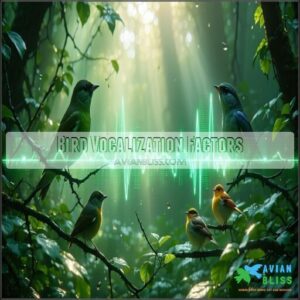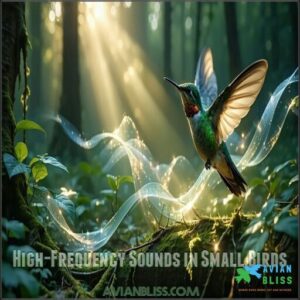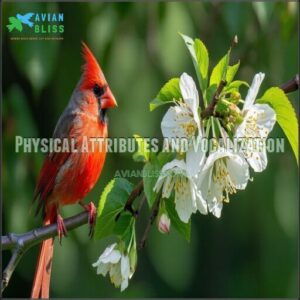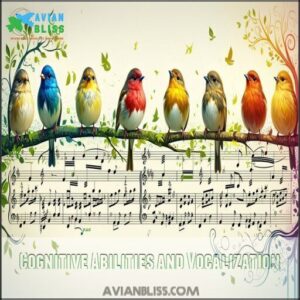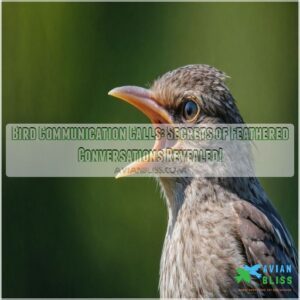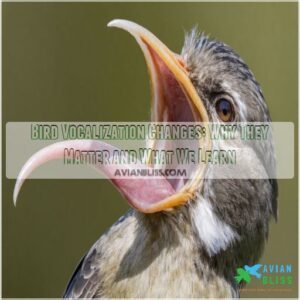This site is supported by our readers. We may earn a commission, at no cost to you, if you purchase through links.

Recent research has revealed multiple factors shaping these complex sounds—habitat acoustics, geographic location, body size, and beak morphology all play pivotal roles.
Small birds typically produce higher frequencies while larger species belt out deeper calls, a pattern that’s evolved over millions of years.
Birds don’t just sing; they’re communicating specific messages about territory, mating availability, and danger.
What’s truly remarkable is how some species can mimic others or even human sounds, offering surprising parallels to our own language development through their neural pathways.
Table Of Contents
- Key Takeaways
- Bird Vocalization Factors
- Bird Sound Production
- Bird Communication Methods
- Conservation and Soundscapes
- Cognitive Abilities and Vocalization
- Frequently Asked Questions (FAQs)
- Why do birds make sounds?
- Why do birds sing?
- Are bird vocalizations a song or a call?
- Does habitat influence bird sounds?
- What types of vocalizations do birds use?
- Do birds discriminate between natural sounds and novel sounds?
- Do birds imitate humans?
- Can a female bird talk?
- Do all bird species have unique songs?
- How do birds learn complex vocalizations?
- Conclusion
Key Takeaways
- You’ll notice that bird vocalizations are shaped by multiple factors including habitat acoustics, geographic location, body size, and beak morphology, with smaller birds typically producing higher frequencies.
- You’re hearing strategic communication when birds adjust their sounds to overcome environmental challenges, using higher pitches near rushing water and shifting frequencies in urban settings to cut through noise.
- You’ll find remarkable parallels between bird vocal learning and human language development, with specialized brain structures that support mimicry and regional dialects.
- You’re witnessing nature’s acoustic indicators when you listen to birds, as their vocalizations serve as critical monitors of ecosystem health and guide conservation efforts.
Bird Vocalization Factors
You’ll find that birds adjust their vocalizations based on habitat conditions, body size, beak shape, and geographic location, with smaller birds producing higher frequencies and those near rushing water adapting their calls to overcome environmental noise.
When you examine these factors closely, you’ll notice that birds at similar latitudes often share sound characteristics, revealing how physical attributes and environment collaborate to shape nature’s complex acoustic communication system.
Habitat Influence on Bird Sounds
You’ll find that a bird’s habitat profoundly shapes its vocalizations. In environments with water noise, birds produce higher-frequency sounds to avoid being drowned out.
Urban birds shift to higher frequencies to overcome city clamor, while forest dwellers develop low-pitched calls that travel better through dense vegetation.
This acoustic adaptation isn’t random—it’s an evolutionary response ensuring effective communication despite environmental challenges. Bird sounds reveal nature’s engineering brilliance, as species modify their acoustic communication to perfectly suit their ecosystem acoustics and habitat conditions.
Geographic Location and Sound Evolution
Throughout the world, bird vocalizations are substantially shaped by geographic location, creating a natural symphony that varies with latitude.
Climate influence and environmental conditions orchestrate the evolution of distinct avian communication patterns.
Research shows three key patterns in sound evolution:
- Species at similar latitudes develop remarkably similar acoustic characteristics
- Isolated populations form unique dialects over time due to evolutionary pressures
- Regional variations create signature "accents" in bird songs across.
Habitat loss can force birds to adjust their calls, leading to changes in avian communication patterns, which are influenced by environmental conditions and regional variations.
Body Size and Sound Frequency
While geographic location shapes regional "dialects" in bird songs, physical attributes determine their fundamental acoustic properties.
The size-frequency correlation in bird vocalizations follows distinct patterns confirmed by global research.
You’ll notice these fascinating relationships:
- Smaller birds produce higher-pitched sounds due to their compact vocal apparatus
- Larger birds generate lower-frequency calls that travel farther through dense environments
- Body mass directly determines acoustic frequency range, creating species-specific sound signatures
This evolutionary adaptation helps birds occupy unique acoustic niches, ensuring effective communication while minimizing sound perception overlap between species, which is crucial for their effective communication and allows them to minimize sound perception overlap.
Beak Shape and Vocalization
While body size determines frequency range, your bird’s beak shape is its true sound-shaping instrument.
Research shows beak morphology affects acoustic resonance more substantially than previously thought. Like specialized musical instruments, beaks amplify and tune bird vocalizations through evolutionary adaptations.
Short, thick beaks produce different sound qualities than long, thin ones. You’ll notice this precision engineering enables birds to create the distinctive songs essential for avian communication.
Bird Sound Production
You’ll discover that birds produce sounds through specialized structures in their respiratory system, with the syrinx functioning as their primary
High-Frequency Sounds in Small Birds
How do smaller birds produce such crystal-clear, high-frequency sounds? Their tiny bodies create acoustic advantages that optimize communication while managing energetic cost.
When you listen to small birds, you’re hearing evolutionary pressures at work through:
- Frequency adaptation that cuts through dense foliage
- Predator evasion through difficult-to-locate calls
- Habitat constraints that shape their acoustic frequency characteristics
- Territorial signaling that maximizes range despite size limitations
- Efficient mate attraction using bird sound frequency ranges optimized for their species
These adaptations enable small birds to effectively communicate and survive in their environments, leveraging their acoustic advantages and frequency adaptation to thrive.
Low-Frequency Calls in Large Birds
While small birds produce high-pitched chirps, you’ll find their larger counterparts creating deep, resonant low-frequency calls that travel impressive distances.
The UW-Madison study confirmed that bird vocalizations directly correlate with body size.
These bass-heavy sounds help large birds communicate through dense habitats in tropical regions, where habitat degradation and overhunting impact their populations.
Their acoustics serve as effective long-distance signals, cutting through environmental noise unlike higher frequencies.
Beak Shape and Sound Characteristics
Beyond the deep bass of larger birds, nature has crafted another acoustic marvel – the bird’s beak. This remarkable structure isn’t just for feeding; it’s a precision-tuned instrument that shapes every sound a bird makes.
Your bird’s beak morphology directly influences its resonance frequencies and vocal range. The relationship between beak shape and sound production is intricate, with various factors contributing to the unique vocalizations of each species.
- Long beaks create slower songs with deeper tones
- Wider beaks produce lower frequency vocalizations
- Beak gape adjustments fine-tune sound amplification
- Evolutionary adaptations in beak shape create distinctive acoustic characteristics
Each beak is basically a custom-built speaker, perfectly evolved for its species’ unique bird vocalizations.
Physical Attributes and Vocalization
Your bird’s physical attributes orchestrate a remarkable symphony of vocalizations.
Body size directly impacts frequency range—larger birds produce deeper sounds while smaller ones create higher pitches.
Meanwhile, beak shape functions as a precision instrument, fine-tuning sound production.
Together, these physical traits form an integrated communication system, allowing birds to broadcast their unique messages through chirps, songs, and calls that reflect both evolutionary adaptations and immediate environmental needs.
Bird songs also help with territorial warnings, which is a crucial aspect of their vocalization and overall behavior.
Bird Communication Methods
You’ll discover that birds employ a sophisticated array of communication techniques, including songs, calls, and remarkable mimicry that serve essential functions from territorial defense to mate attraction.
When you listen carefully to these avian conversations, you’re witnessing complex cognitive processes that parallel human language development, with distinct sounds strategically produced at specific frequencies to overcome environmental challenges, utilizing remarkable mimicry.
Types of Bird Vocalizations
Having explored how birds produce sounds, you’ll now discover their remarkable vocal repertoire.
The avian world features an astonishing array of vocalizations.
You’ll hear alarm calls warning of predators, melodious courtship songs attracting mates, and short contact calls helping flocks stay together.
Young nestlings use begging calls to signal hunger, while juveniles practice with subsongs—similar to human babbling.
Each bird sound serves specific social functions, from territory defense to family bonding, representing nature’s ingenious solution to communication challenges across diverse environments, utilizing their acoustic toolkit for social functions.
Bird Songs and Calls
After exploring various vocal behaviors, you’ll notice bird songs and calls aren’t just random sounds but purposeful vocal repertoires serving critical functions.
When you listen carefully, bird vocalizations reveal remarkable complexity:
- Territorial warnings that declare "this space is taken"
- Melodic song dialects that identify specific populations
- Call functions that alert others to nearby predators
- Avian duets where paired birds coordinate perfectly timed exchanges
These acoustic signatures form nature’s most sophisticated language system.
Mimicry and Vocal Learning
Vocal learning birds demonstrate nature’s remarkable mimicry masterclass through specialized brain structures that facilitate dialect acquisition.
When you listen to a mockingbird’s varied repertoire, you’re witnessing cognitive processes similar to human language development.
Neural pathways in these species enable imitation accuracy that can be startling—from lyrebirds replicating chainsaw sounds to ravens mimicking human speech.
Mimicry evolution has occurred independently across several bird families, suggesting its significant survival value.
Recent studies have even highlighted corvids’ mimicry abilities, showcasing their unexpected aptitude for vocal learning.
The vocal development process begins early, with juveniles practicing imperfect "subsongs" before achieving adult proficiency.
This sophisticated form of communication showcases birds’ exceptional intelligence and adaptability, highlighting their unique ability to learn and mimic a wide range of sounds.
Strategic Use of Sound Frequencies
The masterful manipulation of sound frequencies reveals how birds adapt their vocalizations to overcome habitat acoustics challenges.
You’ll notice they adjust their vocal range to avoid frequency masking from environmental noise, ensuring signal clarity in diverse settings.
This strategic communication isn’t random—birds deliberately shift their acoustic communication patterns, using higher pitches near rushing water and specific bird songs for different purposes.
Their noise adaptation showcases nature’s ingenious solution to communication barriers, and demonstrates how birds use strategic communication to ensure their messages are heard, highlighting the importance of signal clarity in their daily interactions.
Conservation and Soundscapes
You’ll hear the story of ecosystem health through the acoustic records of bird vocalizations, which serve as critical indicators for conservation efforts and environmental change.
When you monitor these natural soundscapes, you’re actually collecting valuable data that helps scientists assess wildlife populations, detect ecosystem disruptions, and guide habitat restoration strategies.
This data is crucial as it helps in detecting ecosystem disruptions and guiding habitat restoration strategies across various environments.
Monitoring Bird Vocalizations for Conservation
While birds communicate through various calls and songs, their vocalizations serve a higher purpose in conservation science.
Acoustic monitoring transforms bird sounds into powerful data for habitat protection efforts. You’ll find researchers using specialized equipment to track population changes through bird song analysis. With advancements in technology, researchers are now using specialized monitoring equipment for data collection.
- Hearing the sudden silence when a species disappears breaks your heart in ways statistics never could
- Watching acoustic biodiversity bloom after successful habitat restoration fills you with hope
- Discovering unique dialects in isolated bird populations connects you to evolutionary timescales
This scientific eavesdropping reveals overhunting signals and soundscape changes, creating conservation roadmaps before it’s too late.
Soundscapes and Ecosystem Health
While tracking bird calls offers essential conservation insights, the full ecosystem story unfolds through soundscapes.
These acoustic landscapes serve as powerful health indicators—where rich, varied sounds signal thriving environments, while silence often indicates habitat degradation.
Soundscape monitoring reveals human impact on natural systems in real-time, and you’ll hear conservation needs through these acoustic biodiversity patterns.
As environmental changes manifest first in altered soundscapes long before they become visible, to effectively analyze these soundscapes, researchers often rely on specialized monitoring devices, which is crucial for understanding ecosystem story and acoustic landscapes.
Citizen Science Contributions
Beyond professional research, citizen scientists form the backbone of acoustic monitoring worldwide.
Bird vocalization research thrives on citizen scientists who record nature’s symphony, creating a global library of avian voices.
Through platforms like xeno-canto, your recordings of bird vocalizations contribute essential data for soundscape analysis and conservation efforts.
The global study analyzing 100,000 recordings relied heavily on birdwatchers’ collective participation.
Citizen science improves data accuracy for conservation.
- Your weekend hobby captures irreplaceable vocal biodiversity data
- Each recording tells a story scientists might never otherwise hear
- Your patient listening helps protect habitats before they fall silent
Conservation Planning and Interventions
While citizen scientists gather data, conservation planners transform these insights into action.
You’ll find bird vocalizations serving as critical indicators for wildlife conservation strategies. Tracking vocal patterns helps identify areas needing habitat restoration.
Acoustic monitoring reveals where soundscape analysis shows vocalization decline, signaling ecosystem distress. Conservation interventions now incorporate these sound-based approaches, with targeted efforts protecting critical habitats where unique bird languages thrive, using bird vocalizations and conservation planners.
Cognitive Abilities and Vocalization
You’ll witness remarkable similarities between bird vocal learning and human language acquisition, as birds demonstrate complex cognitive abilities through their songs and calls.
Their brains process sound information with surprising sophistication, enabling them to mimic environmental sounds, develop regional dialects, and even engage in a practice phase similar to human toddlers’ babbling.
Vocal Learning and Cognitive Capacity
Ever wondered how mockingbirds master their vocal masterpieces?
Research reveals that vocal learning highlights remarkable cognitive abilities in birds.
Their brain structures support mimicry complexity and auditory processing that rivals human language acquisition.
Young birds develop through subsong development stages, balancing instinct vs. learning as they acquire dialect variations.
This sophisticated neural wiring enables birds to memorize, process, and reproduce complex bird songs with astonishing precision, showcasing their cognitive abilities.
Problem-Solving and Brain Size
While vocal learning showcases birds’ communication skills, their brain size reveals even more about their intelligence.
Research shows that birds with larger brain-to-body ratios demonstrate impressive problem-solving abilities and more complex vocalizations.
You’ll notice these fascinating brain size correlations across species:
- Corvids (crows, ravens) use tools and solve multi-step puzzles due to their developed brain structures
- Parrots combine large brains with vocal learning for advanced cognitive processing
- Songbirds with larger brain regions devoted to song production master more complex melodies
These patterns help scientists map the evolutionary path of avian intelligence, which is closely linked to their brain size.
Comparative Studies of Bird Species
While brain size influences intelligence, it’s the comparison between bird species that truly showcases vocal diversity.
When you listen closely to different bird vocalizations, you’ll notice fascinating regional dialects and mimicry variations across species.
These acoustic adaptations illuminate how bird species develop unique song complexity patterns. Some birds master perfect mimicry, while others create distinctive call functions for specific purposes—from territorial announcements to complex social signaling.
Urbanization causes adjustments to bird songs.
Bird communication systems vary remarkably between species, reflecting their cognitive capabilities. This variation is a key aspect of understanding how different species interact with their environment and each other, often through complex social interaction and adaptive behaviors.
Parallels With Human Language Evolution
The fascinating parallels between bird vocalizations and human language evolution reveal nature’s blueprint for communication.
When you study songbirds, you’re witnessing cognitive processes remarkably similar to our own language development.
- Brain structures dedicated to vocal learning exist in both humans and songbirds
- Genetic mechanisms like FoxP2 regulate speech in both species
- Auditory processing follows similar developmental pathways
- Subsong babbling in juvenile birds mirrors human infant babbling
- Both systems demonstrate dialectal variations across geographic regions
These similarities suggest ancient evolutionary pathways shaped animal communication systems long before human language emerged, following a shared developmental pathway that is remarkably similar in both species, and influenced by genetic mechanisms.
Frequently Asked Questions (FAQs)
Why do birds make sounds?
Clear as a bell, you’ll find birds make sounds for survival and social reasons. They’re communicating to attract mates, defend territory, warn of dangers, and maintain contact with their group.
Why do birds sing?
Birds sing primarily to attract mates and defend territory.
You’ll notice they’re also communicating social status, warning of predators, and reinforcing pair bonds.
Their songs aren’t just pretty—they’re survival tools with specific purposes, and they play a crucial role in the birds’ ability to attract mates.
Are bird vocalizations a song or a call?
In a groundbreaking study analyzing 100,000+ recordings, researchers found birds use both songs and calls.
You’ll hear songs for courtship and territory, while calls serve as short, functional communications for alerts or contact, which is a functional aspect of their behavior.
Does habitat influence bird sounds?
Yes, habitat dramatically shapes bird vocalizations.
You’ll notice that birds near rushing water produce higher-frequency sounds to prevent being drowned out, while forest dwellers typically use lower-pitched calls adapted to their surroundings, which is a result of their surroundings.
What types of vocalizations do birds use?
You’ll hear birds using various vocal types including songs for attracting mates, calls for warnings, contact calls to locate flock members, and begging calls from nestlings.
Some species even master impressive mimicry abilities, including various vocal types.
Do birds discriminate between natural sounds and novel sounds?
A fascinating study found that 84% of tested bird species can distinguish between natural and novel sounds.
You’ll find their sophisticated auditory processing allows them to recognize familiar vocalizations while identifying potentially important unfamiliar ones, which showcases their ability to handle complex sounds.
Do birds imitate humans?
Some bird species can indeed imitate your speech and other human sounds.
Parrots, mynas, and mockingbirds are particularly skilled at this, with their remarkable vocal learning abilities allowing surprisingly accurate reproductions of words you’ve spoken, utilizing their vocal learning abilities.
Can a female bird talk?
While males get all the glory, female birds certainly don’t remain silent.
You’ll find they can vocalize through calls and chatter, though in many species they’re quieter and use simpler sounds for communication.
Do all bird species have unique songs?
No, you’ll find many bird species share similar song patterns, while others possess truly unique vocalizations.
Songs vary based on habitat demands, geographical location, body size, and beak shape—creating distinctive acoustic signatures across different populations.
How do birds learn complex vocalizations?
Young birds learn vocalizations through a process similar to human language acquisition.
They start with subsongs (like babbling) and practice extensively.
Their brain structures enable complex mimicry and precise sound reproduction.
Conclusion
Just as you might decode a foreign language, scientists continue revealing the secrets of bird vocalizations revealed through decades of research.
You’ll appreciate how these evolved communication systems serve essential biological functions while demonstrating remarkable complexity.
Whether you’re listening to a robin’s morning call or a mockingbird’s elaborate repertoire, you’re witnessing millions of years of acoustic evolution.
Understanding these natural symphonies enriches our connection to wildlife and also provides valuable insights into our own language development.

